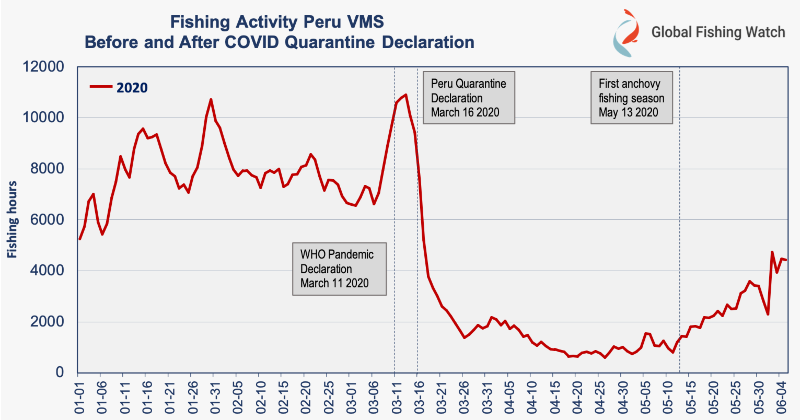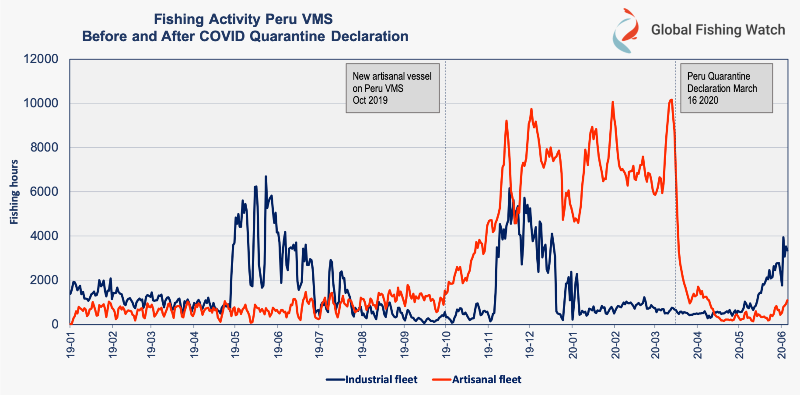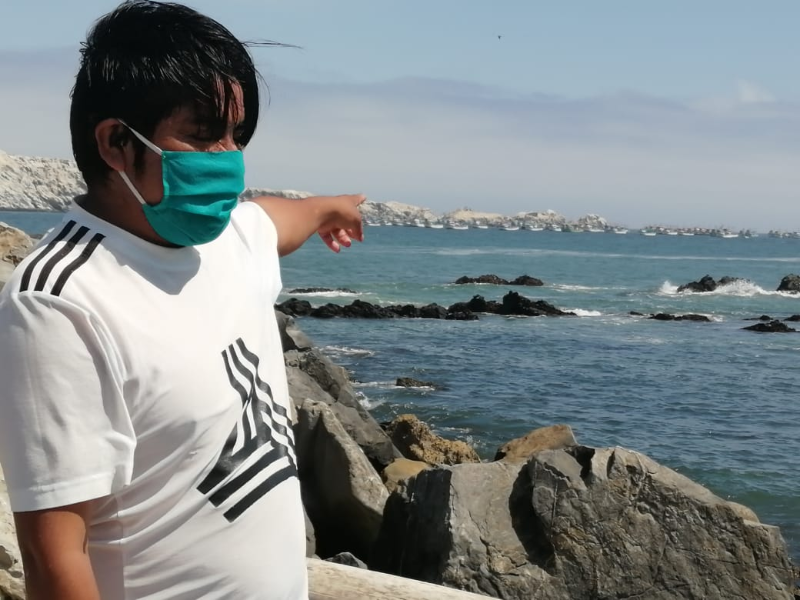One of world’s biggest fishing nations faces economic setbacks, turns to artisanal fleet for food security
This is the second blog in a series on the effects of COVID-19 on global fishing activity. Read our initial analysis of changes in global fishing activity during the pandemic here.
According to the Global Fishing Watch database, fishing activity in the Peruvian vessel monitoring system dropped approximately 80 percent after the Peruvian government declared a stay-at-home order in response to the COVID-19 pandemic on March 16, 2020. Peru, the world’s second largest fishery by catch volume, has seen its fishing vessel activity contract dramatically due to the pandemic. The industrial fleet ceased operations entirely and the artisanal fleet is struggling to continue operating. The pandemic’s impact and the daily oscillation of Peru’s fishery effort can be seen on the public Global Fishing Watch map.

Peru is the world’s leading producer of fishmeal, made from anchovy, and a leading producer of jumbo flying squid and mahi-mahi. These fishmeal and frozen squid are mainly exported to markets in China, and the frozen mahi-mahi is primarily exported to the United States – both countries are major importers of Peru’s seafood product and resulted in about US$ 890 million revenue last year. But all this changed when the World Health Organization declared a global pandemic on March 11, 2020 due to the spread of COVID-19.
Five days after the pandemic was announced, Peruvian President Martín Vizcarra declared the start of mandatory social isolation, first for a period of 15 days , which was later extended through May. Vizcarra emphasized that these measures would not prohibit essential activities such as fishing for human consumption. However, captains and crew decided to return to shore to be safe with their families. This choice by fishers can be seen in the dramatic nearly 80 percent drop in fishing effort one week after the order was implemented (Figure 1).
The big role of the artisanal fishers in the Peruvian food security

2020 started out as a good year for the Peruvian artisanal fishing sector with a big boost in the transparency of the artisanal fleet. As measured by Global Fishing Watch, Peru’s fishing hours in the first quarter (January-March) of 2020 increased by about 70 percent (orange line in Figure 2) compared to the previous year. This increase in measured fishing effort is due to the expansion of Peru’s vessel monitoring system (VMS), which now monitors the fishing activity of an additional 400 small-scale vessels. These additional vessels began using VMS by the end of last year, bringing the total number of vessels in the VMS system to 1,400. By effectively monitoring fleet activity, Peru can ensure relevant rules are followed.

During the last two months (March 16 – May 16, 2020) of mandatory social isolation, the Peruvian artisanal fishing fleet has played an important role. While they have reduced their fishing significantly, they have continued catching important species for domestic consumption, such as bonito and jack mackerel. The pandemic has given Peruvians an increased understanding of the importance of artisanal fishers.
Global Fishing Watch has been working closely with three fishing cooperatives in northern Peru: Islilla, La Tortuga, and San José. To comply with the government’s new regulation, the owners of 400 small-scale vessels decided to invest their savings in installing satellite monitoring equipment. Fidel Fiestas, vice president of the Islilla Fisheries Cooperative stated, “Shipowners expected to recover the investment made in the first quarter of 2020, but the COVID-19 stopped everything, 100 percent our fleet is stuck in the harbor due to the squid and mahi-mahi demand dropped by the Peruvian frozen industry.“
Una semana de esfuerzo pesquero utilizando datos AIS (azul claro) y VMS Peruano (amarillo) antes de la cuarentena en el Perú (9-16 de Marzo del 2020 ) y un mes después de la orden de permacer en casa (16-23 de Abril del 2020). Mueva la barra deslizante a través de la imagen para ver la diferencia entre el antes y después.
The president of the Committee for the Sustainable Management of the Giant Squid, Alfonso Miranda Eyzaguirre, commented, “The Peruvian frozen industry will be closed as international markets reopen. Peru has stopped its artisanal squid fleet, while the Asiatic squid fleet continues fishing outside Peruvian waters, in the midst of a global pandemic.” According to the Global Fishing Watch fishing activity based on the automatic identification system (AIS) data, two months ago during Peru’s quarantine, the Asiatic squid fleet moved from the Eastern Equatorial Pacific (Galápagos Islands) to the boundary of Peru’s EEZ. At the time of publication, there are 235 industrial squid vessels fishing just outside Peru’s EEZ (233 are flagged to China and the remaining 2 are flagged to Taiwan).
A tiny fish (anchovy)
2019 was not a good year for the Peruvian anchovy fleet. The second fishing season for Peruvian anchovy (November 16, 2019 – January 15, 2020) (Figure 2) only reached 36 percent of the quota of 2.786 million tons (highest quota in history), due to the high presence of juveniles and an unfavorable change in oceanic characteristics. The fleet hoped 2020 would be better. But the arrival of COVID-19 in Peru forced the fishers to stay in port.

Industrial fishing activity in Peru typically peaks during the anchovy fishing seasons (Figure 2). Around 850 purse seiner vessels go in search of this tiny fish. Typically, the first anchovy season begins in April. Unfortunately, as Global Fishing Watch’s data show, Peru’s fishing effort has not yet recovered since the quarantine began on March 16, 2020 (Figure 2). Even when the Ministry of Production decided to begin the first anchovy season on May 13, 2020 as part of the resumption of essential activities, the small increase in the fishing activity does not match that observed in the year’s past (Figure 2).
The Peruvian government is preparing a series of measures to reactivate the economy, including the fishing sector. In the following months, the government, the private sector, universities, and nongovernmental organizations must work together to rebuild the Peruvian fishing industry. An example of this is the launch of the recent campaign, “Keeping Fishing COVID-19 Free.”
Global Fishing Watch reaffirms its commitment to Peru, one of the world’s leading fishing countries, in support of their monitoring, control and surveillance of fishing vessels and fisheries. As global ways of working are affected by necessary COVID-19 responses, the innovative use of cost-effective technologies and the sharing of information is extremely important. Peru is leading the way in this regard. Globally, others must follow by adopting fisheries transparency to support fisheries management and ensure future ocean resilience.
Eloy Aroni is a fisheries analyst at Global Fishing Watch.
